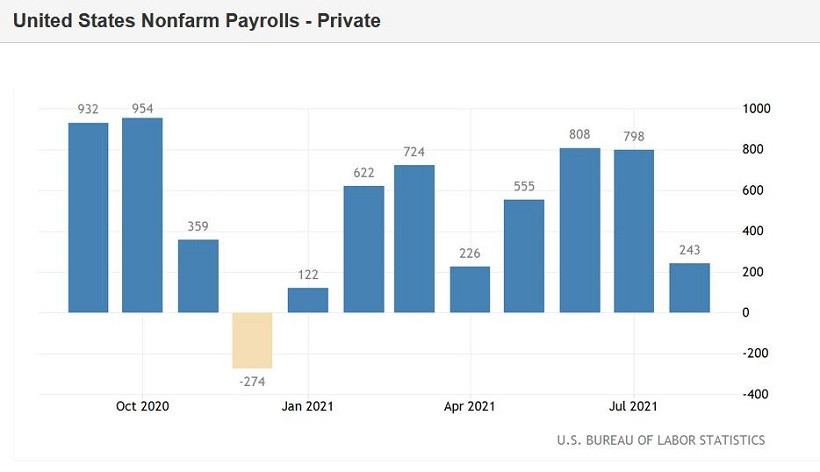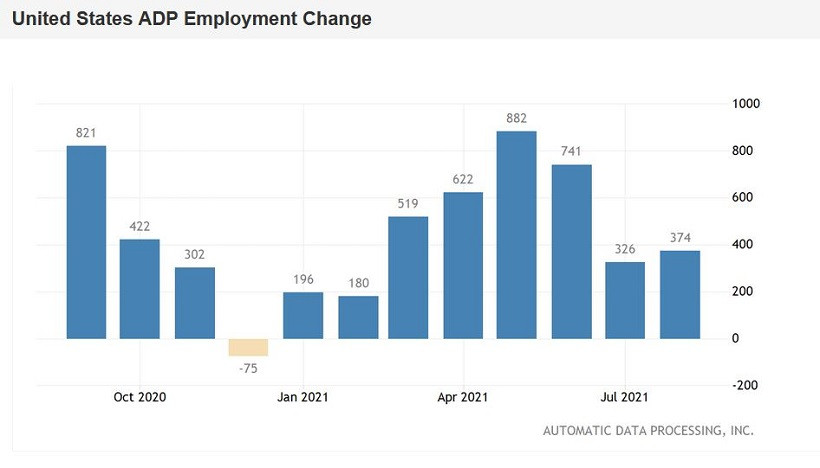After a 5-day consecutive decline and a subsequent 2-day corrective growth, the EUR/USD pair drifted, settling on the border of 15 and 16 figures. Traders, figuratively speaking, conduct reconnaissance, assessing their opponents' strengths and capabilities. The bulls are clearly exhausted, after having difficulty organizing a fairly modest 80-point correction from the 1.1560 mark. The "ceiling" of the corrective pullback was the mark of 1.1640, which turned out to be too much for EUR/USD bulls. Bears, in turn, still cannot confidently gain a foothold within the 15th figure, despite the bearish sentiment dominating the pair.

Apparently, traders need an information driver – a powerful news impulse that will push the pair out of the clutches of a temporary flat. Obviously, the next most important macroeconomic report will be published on Friday. September Nonfarm will either strengthen the greenback's position, or allow bulls to organize a correction again. There is no need to talk about a trend reversal: given the prevailing fundamental background, EUR/USD bulls can only count on a large-scale correction, which a priori is temporary and very fleeting.
On the side of the US currency – the continued growth of the oil market (today the barrel of Brent has updated a 3-year high again, rising above the $82 mark), continuing problems in supply chains (in the context of the engine of inflationary growth) and the hawkish attitude of many Federal Reserve representatives. Well, in the end, it cannot be said that the yield of 10-year treasuries has again crossed the one and a half percent mark today, reflecting the general trends in the markets.
Nevertheless, dollar bulls lack one more piece of the puzzle - strong Nonfarm.
For many months, the US labor market has served as a loyal ally of the greenback. The unemployment rate in the United States has been consistently declining since June 2020, reaching a target of 5.2% in August. This indicator is gradually moving into the area of pre-crisis values. Wages are also growing: the average hourly wage in August jumped by 0.6% on a monthly basis and by 4.3% year-on-year. But the headline indicator of Nonfarm from a month ago alerted market participants. After three months of dynamic growth, the indicator of growth in the number of people employed in the non-agricultural sector collapsed to the level of 235,000. Despite the fact that in July this figure exceeded the millionth mark, and in August it was supposed to reach 760,000. But the real result was three times lower. Such an unexpected contrasting cold shower allowed Fed Chairman Jerome Powell not to rush to hawkish conclusions in Jackson Hole. He voiced cautious rhetoric, taking a wait-and-see attitude. Following the results of the economic symposium, the dollar weakened significantly throughout the market - paired with the euro, the greenback fell by 200 points. Then the hawkish expectations strengthened again against the background of the announced completion of QE, the growth of oil prices and other factors that accelerate inflation.
But here there is another problem that does not allow dollar bulls to organize another large-scale offensive. The word "stagflation" has become more and more common in analytical notes and reports of currency strategists. An increase in inflation against the background of stagnation or a slowdown in the growth of the labor market and production can significantly slow down the process of recovery of the US economy (such prospects shine not only to the US, but in this case we are talking about the United States). Talking about possible stagflation frightens traders, forcing them not to rush into trading decisions regarding the greenback. That is why Friday's release will be of such great importance for the EUR/USD pair and for other dollar pairs. And given this background, tomorrow's report from the ADP agency, which is the "petrel of Nonfarm", may also provoke increased volatility.


I note that the August Nonfarm reflected a relatively high correlation with the report from the ADP agency, whose specialists announced an increase in the number of people employed in the private sector by 370,000. According to official data, 243,000 jobs were created in the private sector of the economy. Therefore, if tomorrow's ADP report comes out in the red or green zone (i.e. it will differ from the forecast level), the dollar will demonstrate increased volatility. The direction of the EUR/USD price will depend on the "color" of this release.
If we consider short-term trading, then it is best to take a wait-and-see position before the publication of the ADP report. But if we talk about medium-term (and even more so long-term) periods, then in this case it is advisable to open short positions at the peak of corrective upward pullbacks (for example, the last wave of corrective growth began to fade in the area of 1.1630-1.1640). The first target of the downward movement is the 1.1560 mark – this is the lower line of the Bollinger Bands indicator on the D1 timeframe. The next price barrier is located slightly lower, at 1.1530 (the lower line of the Bollinger Bands coinciding with the lower boundary of the Kumo cloud on W1). It is too early to talk about lower values (1.1500 and below), since traders will not dare to make such a large-scale decline before Nonfarm.
The material has been provided by InstaForex Company - www.instaforex.com